Disclosure: Meeple Mountain received a free copy of this product in exchange for an honest, unbiased review. This review is not intended to be an endorsement.
The year was 1957 and The Soviet Union had recently launched the first satellite, the Sputnik 1, into outer space. With this, the gunshot had been fired and the starting line had been crossed. The space race was on!
You can also check out our video review of Space Explorers.
Overview
Space Explorers takes place during an exciting time in human history as the world powers worked feverishly to be the first ones to send spacecraft and people into orbit and beyond. Each player controls an R&D Hub in a Space Research Center and will spend the game trying to attract the most brilliant minds to join their teams. They’ll be competing to be the first to complete several large scale projects in order to score the most points. Each R&D Hub is broken up into different research divisions (simply referred to as ‘divisions’ from here on) and these divisions produce the resources needed to hire Specialists and complete the projects needed in order to win the game.
If you’re just interested in what I think about Space Explorers, feel free to scroll down to the Thoughts section. For the rest of you…
Gearing Up
Each player is given an R&D Hub which is assembled and placed in front of them. Then the Specialist cards are shuffled together into a deck and each player is dealt one card each to form their starting hand. Then the remaining cards are placed as a face down deck into the middle of the playing area and six are drawn from the top and placed face up beside the deck. Each player also receives one Research tile of each type (for a total of 5 tiles) to begin the game with.
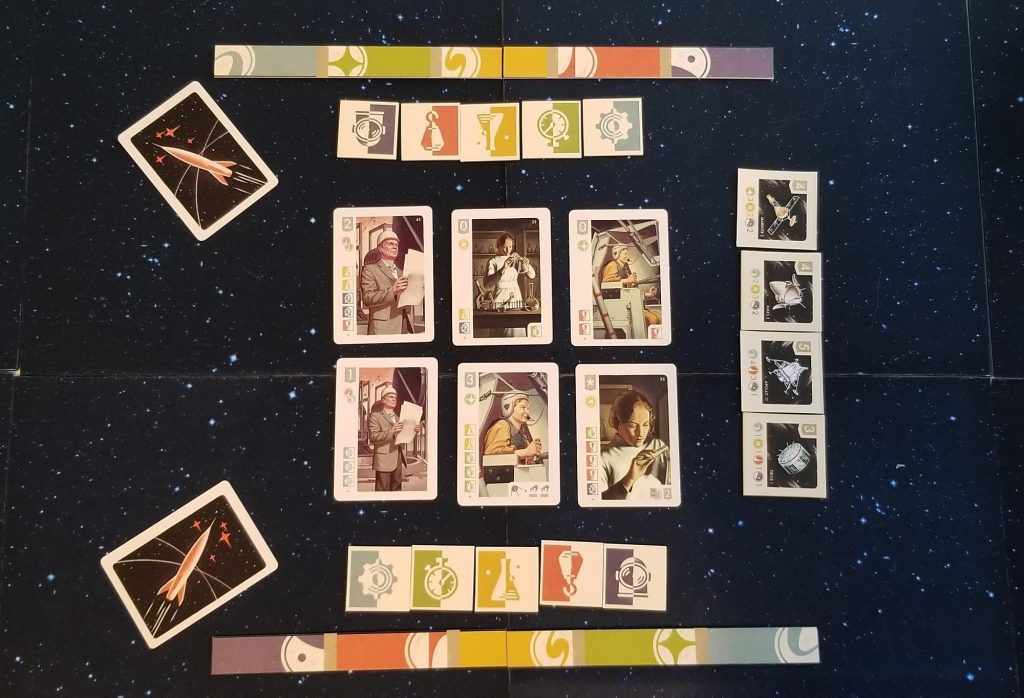
Next, a number of Project tiles (dependent on player count) are randomly selected and placed close to the playing area. These are double-sided and players can use whichever side of the tiles that they wish. One side will show a Soviet space project while the other side will display an American one. The rule book suggests flipping the tile, but you can use some other method if you desire. Finally, a starting player is selected by some means and given the starting player marker. Now, you are ready to begin playing Space Explorers!
Building Your Team
Before you can begin completing projects, you will need to hire Specialists to populate the different divisions of your R&D Hub. The first action available to you (and likely the first action you will take in the game) is to simply add one of the face up Specialists (or a blind draw from the top of the deck) to your hand. The second action is to actually recruit one of these Specialists from your hand, or from the face up display, to one of your divisions. The division the Specialist can be recruited to depends entirely upon the Specialist’s skills. Then there is the matter of whether or not you have the resources on hand to hire them in the first place.

At the top left of each Specialist card are icons depicting the Specialist’s skills. Each of these icons also matches one of the division icons. A Specialist with a green icon, for instance, can only be recruited to the green division. If the Specialist had both a green and a red icon, they could be recruited to either the red or green divisions. At the bottom left of each Specialist card is the recruitment cost of the Specialist.
Recruiting that first Specialist to a division would require you to pay the full recruitment cost. Further recruitments to the same division would have some (or possibly all) of their recruitment costs discounted. Payment can come from one of three places. First, you may discard a Specialist card from your hand into the face up display for any two research symbols of your choice. Secondly, you can use the Research tiles that you received at the beginning of the game. Any Research tiles that you use are taken from your supply and given to the player on your left. Lastly, some Specialist cards provide free research symbols when they are recruited to your divisions.
Newly recruited Specialists are placed on top of existing Specialists but splayed in such a way that you can still see the skill icons of the previously recruited Specialists underneath them. It is worth mentioning here that most Specialist cards provide a unique benefit (shown at the bottom right of the card) when they are recruited to your divisions, but only the Specialists with visible benefits actually provide them. This means that once you hire a new Specialist to a division, you lose the benefit provided by the previous Specialist.
As I mentioned earlier, it is possible that you might receive a discount when recruiting a new Specialist. To determine the discount you will receive (if any), look at the existing Specialists in that division. For each skill icon that matches that division, the cost to recruit the new Specialist is reduced by one research icon moving from the bottom of the card up.
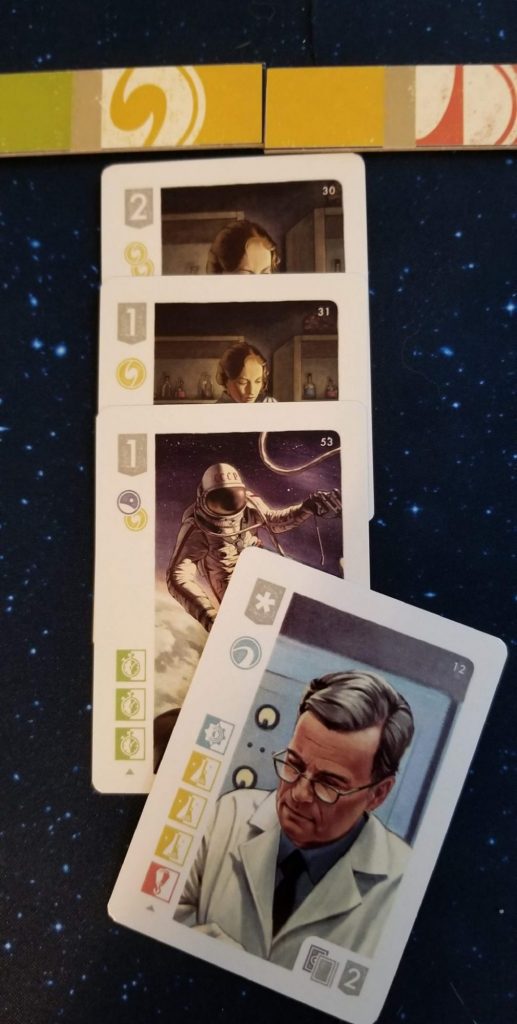
Blasting Off
So, the game is well underway. You’ve got a solid team of Specialists and the person on your right has you overflowing with Research tiles. What do you do with all of these resources? You complete projects, that’s what!
At the beginning of the game, several projects were randomly selected. Each of these projects has a skill cost associated with completing it. This cost is shown along the bottom of the project. Each project, when completed, is collected by the person that completed it and will be worth a number of victory points (shown at the top left) at the end of the game. A project can be completed at the end of your turn by comparing the skills provided by your Specialists compared to the skills required to complete the project. If there is a match, then you can complete it, but you can only complete one project per turn.
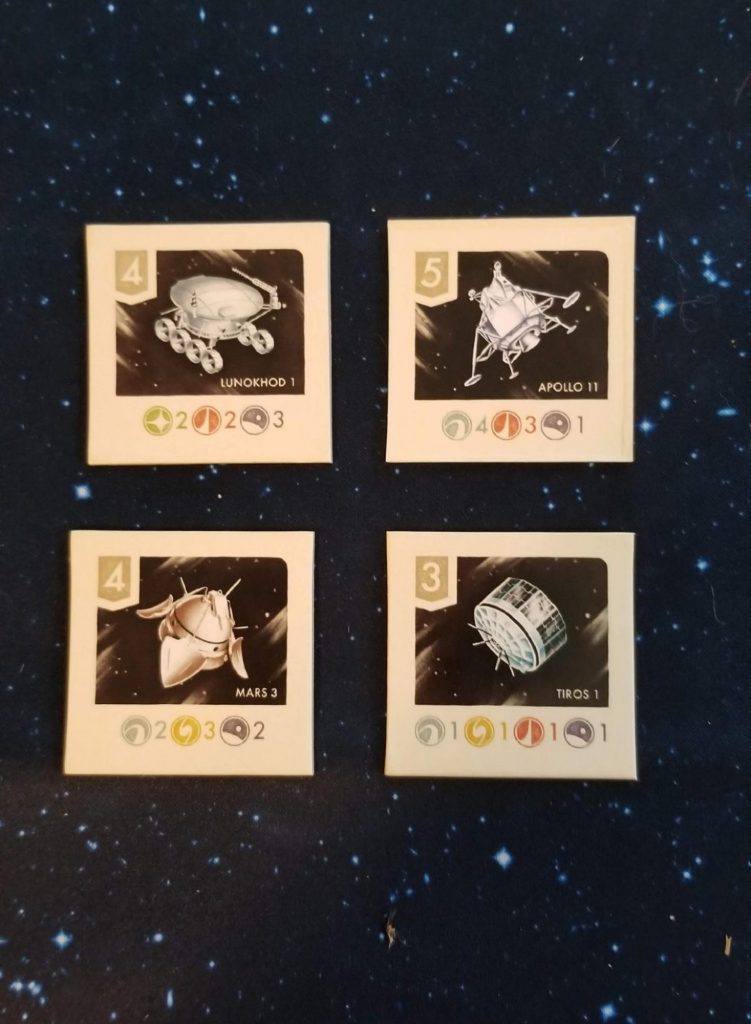
Completing the Mission
The end of the game begins once all of the available projects have been completed or one person has recruited twelve Specialists into their R&D Hub. The current round is completed such that every person has had an equal number of turns. Then the final scores are determined. Victory points can come from several places. Each completed project is worth an amount of points. Each recruited Specialist provides a number of points. And, finally, some Specialists’ special abilities provide points at the end of the game if certain criteria are met. The person with the most victory points wins.
Thoughts
The very first thing that I noticed about Space Explorers was the artwork. It has a very retro early space era feel about it. It puts me in mind of old propaganda posters of the time and it is magnificent. Aleksei Kot’s illustrations really set the mood and make me feel like I’m actually there. My only gripe with his work is that I wish there were more of it. Each Specialist type has a generic image that goes along with it. Every scientist looks the same, every engineer looks the same, etc. I wish that there were different illustrations within each type just to change it up a bit. Still, though, this game has some of the best artwork I have ever seen.
A long time ago, before I ever became involved with Meeple Mountain, I had the good fortune to try out and review one of Yuri Zhuravljov’s previous games (and probably his most well-known) – Viceroy. Playing Viceroy was an amazing experience. The way that the mechanics came together in that game was like nothing I’d ever seen before and it still continues to be one of my favorite games (and one of my favorite reviews!) to this day. When Meeple Mountain was contacted about reviewing a new game by Yuri, it was a no-brainer. I was immediately on board, sight unseen. Just a quick glance at the BGG entry for Space Explorers showed me a game that definitely looked attractive and sounded interesting, but would it play well? Would Yuri Zhuravljov knock it out of the park the same way he did with Viceroy? So it was that I found myself watching my mailbox eagerly. And finally it arrived.
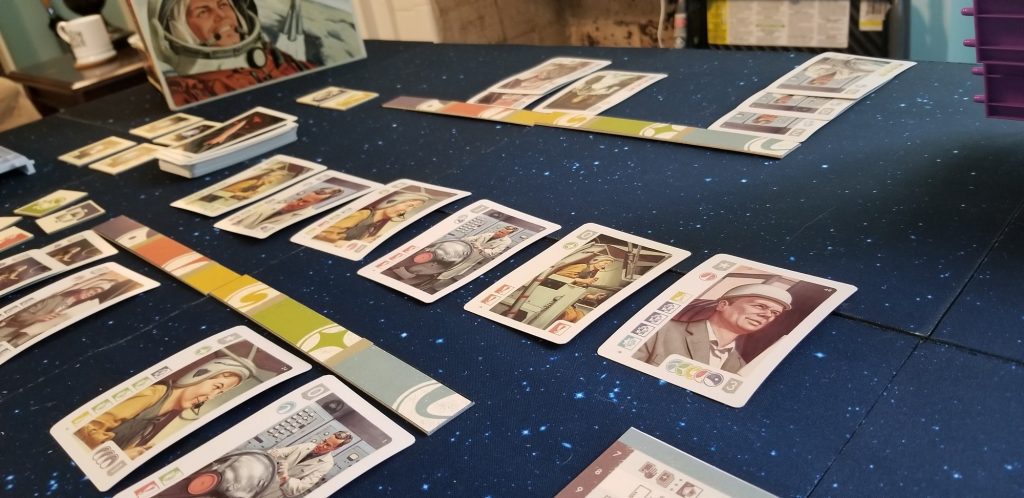
It is obvious right from the start of playing Space Explorers that it was heavily influenced by games like Splendor. It’s got that familiar ‘collecting sets of cards that makes it cheaper to buy further cards to add to your tableau’ element about it that makes it impossible not to compare it to Splendor. Even the Project tiles are similar to the Nobles in that other game. In Splendor, you’re collecting gems from an ever whittling pool of gems, printed on poker chips, in order to purchase cards from a lineup in an effort to score victory points. Each of those cards produces gems which, combined with the poker chips, makes it easier to purchase even better, higher scoring cards. Space Explorers is very similar in this aspect and if I were to stop the review right now, you’d probably be asking yourself why you should purchase Space Explorers over its predecessor.
There are several things that really set Space Explorers apart. First, most Specialist cards provide a unique ability that sometimes lead to some interesting card combinations. For instance, in one game that I played with my sister there was a Specialist (Specialist A) that allowed you to recruit a Specialist from the lineup that cost two research or less. I had previously recruited a different Specialist (Specialist B) whose ability was that if he got covered up by another Specialist, I could draw two cards from the top of the deck. By recruiting a free Specialist using Specialist A’s power, I was able to cover up Specialist B causing his ability to trigger. Then I was left with two cards in hand which I was able to use to pay most of the cost of a very expensive Specialist on my next turn. Awesome turns like that simply do not occur in Splendor.
The second thing that sets Space Explorers apart is the byproduct of the behavior which I just described in the previous paragraph. Unlike most games where cards removed from your hand would go to some discard pile, the cards removed from your hand in Space Explorers go directly into the lineup. Thematically, these people are leaving your research team and become part of the job market. This adds a lot of interesting tactical decision-making to the game. You have to pay attention to what your opponents are doing and which Projects are still available. You might have the cards in your hand to discard in order to play something big, but those discards might give your opponent exactly what they need in order to snag one of the Projects on their turn. Is the ability to play the big card worth giving up those points to your opponent? Or should you hang onto the cards in your hand and try to play them yourself? It’s never an easy decision as the cards in your hand can serve as either the currency needed to get your engine going or the pieces of the actual engine itself.
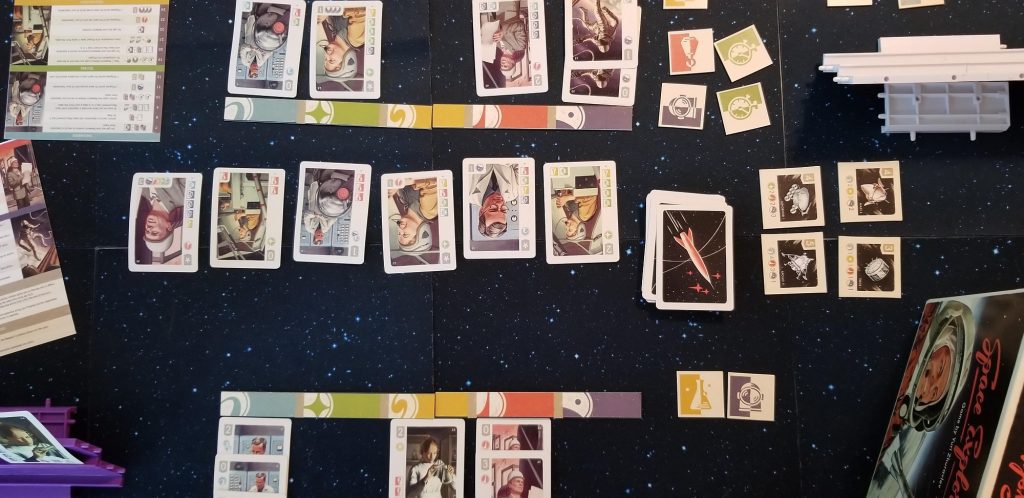
A third thing that sets the game apart is that each Specialist can only belong to a specific division/ specific divisions – determined by the Skill icons printed on the card. The ability to use previously recruited Specialists to discount the cost of new hires to a division is very important in this game, so you might be tempted to specialize. Specialize too much, though, and you won’t be able to come up with the Skill icons needed to claim the Projects. There’s a balance that must be struck and finding that balance just adds another interesting challenge to the game.
All in all, I have enjoyed playing Space Explorers. Thematically, artistically, and mechanically it just checks off a lot of boxes for me. The game is very easy to teach and easy to learn. The hardest thing to wrap your mind around is that skill icons and research icons are very different things. The game plays fairly quickly and, unlike Viceroy, it has a pretty small table footprint. It’s a handsome, very clever game and it’s definitely got my seal of approval.












